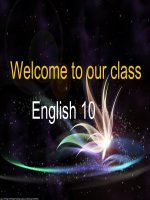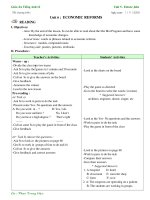ENGLISH 10 UNIT 12 READING
Bạn đang xem bản rút gọn của tài liệu. Xem và tải ngay bản đầy đủ của tài liệu tại đây (102.51 KB, 2 trang )
Trainee teacher: Nguyễn Thị Hà Xuyên.
Instructor: Nguyễn Hoàng Diệu Thư
Date: February 16, 2011.
Lesson Plan: English 10.
UNIT 12: MUSIC
READING
Objectives:
By the end of the lesson, Ss will be able to:
- Learn more vocabulary.
- Improve their reading skill as scanning for specific information and guessing meaning in context.
- Gain more knowledge about the role of music in our life.
- Recognize music as an integral part of our life.
Major teaching method:
Communicative Approach
Procedure:
Teacher 's activities Students’ activities
I. Warm up: (5’)
- Ask Ss some questions :
1.Do you like listening to music ?
2.What band do you like best?
3.What singer do you like best?
4.What sort of music do you often listen to ?
5.Can you name some singers or bands who play pop
music?
- Work individually.
- Listen to T’s questions.
- Answer the questions aloud in front of class.
II. Pre-reading:
Activity 1: (5’)
- Ask Ss to read aloud the types of music and give the
Vietnamese equivalents of the types of music.
1. Fork music: nhạc dân ca.
2. Rock ‘n’ roll: nhạc rock ‘n’ roll.
3. Pop music: nhạc pop.
4. Classical music: nhạc cổ điển,
5. Jazz: nhạc Jazz.
Activity 2: (5’)
- Ask Ss to work in pairss to match each of the
descriptions to a type of music on page 124 in the text
book.
- Give feedback.
- Ask Ss to provide other kinds of music, such as:
R&B, Hip-hop, Country, etc.
Activity 3: (7’)
- Provide some vocabulary and give the meaning.
+ Emotion (n): a strong feeling, the part of a person's
character that consists of feelings (cảm giác, cảm xúc)
+ Anger (n,v) Angry (adj).
+ Integral part: Essential part (phần thiết yếu).
+ Funeral (n): a ceremony for burying or burning a
dead person (đám tang).
+ Mournful (adj): very sad (tang tóc, thê lương).
+ Lull (v): to cause someone to feel as if they want to
sleep.
- Speak aloud the vocabulary and ask Ss to repeat.
- Work individually.
- Speak aloud the types of music and give the
Vietnamese equivalent of each.
- Work in pairs
- Open and look at the text book, page 124.
- Read carefully the table then discuss and match each
of the descriptions to a type of music.
Suggested answers:
1b 2e 3d 4a 5c
- Work individually.
- Look at the vocabulary then guess the Vietnamese
equivalents.
- Listen to the pronunciation and repeat aloud.
- Write down the vocabulary into the notebook to learn
by heart.
III. While reading: (15’)
- Ask Ss to scan the passage to recognize the general
idea.
- Explain if Ss have any words that they don’t
understand.
Task 1:
- Ask Ss to read the words in the box then provide the
meanings and part of speech.
- Ask Ss to complete the sentences.
- Have Ss read aloud the answer then give feedback.
Task 2:
- Ask Ss to read the passage again and answer the
questions on page 126 in the textbook.
-Call on some Ss to answer in front of the class
-Listen and give feedback
- Whole class.
- Scan the passage to recognize the general idea.
- Ask T if they have any words that they don’t
understand.
- Read the words in the box then provide the meanings
and part of speech.
- Work in pairs, complete the sentences.
- Read aloud the answers.
Suggested answer:
1.communicate 2.lull
3.delights 4.intergral part
5.solemn 6.emotion
7.mournful
Work in pairs.
- Read again the passage and answer the questions.
- Speak aloud the answers.
IV. Post reading: (5’)
- Divide Ss into a few groups, each group includes 3
or 4 Ss.
- Ask groups to discuss then answer 2 questions in the
textbook.
- Call some groups to answer aloud.
- Give feedback.
- Work in group.
- Read carefully the questions in the textbook.
- Discuss and answer the questions.
- Read aloud the answers.
V. Review and Homework: (3’)
- Review the significance of music to our life.
- Ask Ss to learn by heart the vocabulary and do again
3 tasks in the textbook.
- Prepare the next lesson, Unit 12, session Speaking.
- Listen to the review and remember.
- Learn by heart the vocabulary.
- Do the homework.
- Prepare the next lesson.
Comments:









